Click on images to enlarge
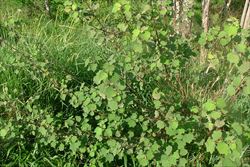
habit (Photo: Sheldon Navie)
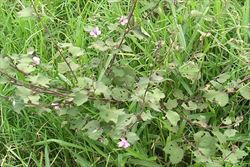
habit (Photo: Chris Gardiner)
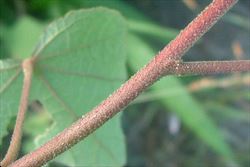
close-up of younger stem and leaf stalks covered in star-shaped hairs (Photo: Sheldon Navie)
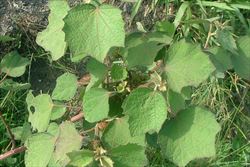
variable leaves (Photo: Sheldon Navie)
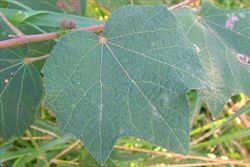
close-up of a broad, somewhat-lobed, lower leaf (Photo: Sheldon Navie)
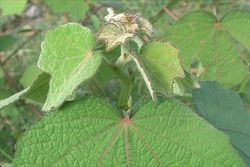
young leaves (Photo: Sheldon Navie)
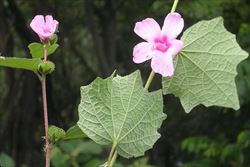
flowers, young fruit and leaf undersides (Photo: Chris Gardiner)
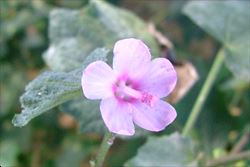
close-up of pink flower (Photo: Sheldon Navie)

immature fruit (Photo: Sheldon Navie)
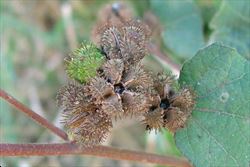
close-up of mature fruit with five segments covered in hooked spines (Photo: Sheldon Navie)

close-up of seeds (Photo: Steve Hurst at USDA PLANTS Database)
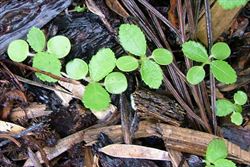
seedlings (Photo: Sheldon Navie)
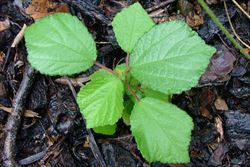
young plant (Photo: Sheldon Navie)
Scientific Name
Urena lobata L.
Family
Malvaceae
Common Names
aramina, bur mallow, Caesar weed, Caesar's weed, Caesarweed, Congo jute, hibiscus burr, pink burr, pink Chinese burr, pink-flowered Chinese burr, urena burr, urena weed
Origin
This species is found throughout the tropical regions of the world (i.e. it has a pan-tropical distribution), but it was probably spread to large parts of this current range by aboriginal voyagers through its use as a fibre plant. It probably originated in tropical Asia (i.e. China, the Indian Sub-continent and south-eastern Asia), however it is sometimes also regarded as being native to parts of northern Australia.
Naturalised Distribution
Now almost always regarded as being naturalised in northern and eastern Australia (i.e. in northern Western Australia, the northern parts of the Northern Territory, northern and eastern Queensland and the coastal districts of northern New South Wales).
Also naturalised in south-eastern USA (i.e. Louisiana and Florida), La Réunion, Papua New Guinea and on numerous Pacific islands (e.g. American Samoa, the Cook Islands, the Federated States of Micronesia, Fiji, French Polynesia, Guam, Niue, the Solomon Islands, Tonga and Hawaii).
Habitat
A weed of waterways (i.e. riparian vegetation), swamps, forest margins, open woodlands, roadsides, waste areas and disturbed sites in tropical and sub-tropical regions.
Habit
An upright (i.e. erect) and long-lived (i.e. perennial) herbaceous plant or small shrub usually growing 0.5-2 m tall, but occasionally reaching up to 3 m in height.
Distinguishing Features
- an upright and long-lived herbaceous plant or small shrub growing 0.5-3 m tall.
- its younger stems are densely covered in star-shaped hairs, while its older stems become somewhat woody with age.
- its alternately arranged leaves (4-10 cm long) have toothed margins and vary from being almost entire to shallowly three-lobed.
- its pink flowers (about 1.5-2 cm across) are usually borne singly on short stalks in the upper leaf forks.
- its fruit (6-10 mm across) are covered in numerous small hooked spines and split into several one-seeded segments when mature.
Stems and Leaves
Its younger stems are green and densely covered in star-shaped (i.e. stellate) hairs, while its older stems become woody with age.
The alternately arranged leaves (4-10 cm long and 1.5-8 cm wide) are borne on stalks (i.e. petioles) 1-9 cm long. The lower leaves are egg-shaped in outline (i.e. ovate) or somewhat circular (i.e. orbicular) in shape and vary from being almost entire to shallowly three- or five-lobed. However the uppermost leaves are smaller and narrower (i.e. oblong or lanceolate), usually being only 4-7 cm long by 1.5-3 cm wide. All leaves have toothed (i.e. serrate or crenate) margins and pointed tips (i.e. acute apices). Both leaf surfaces are covered in star-shaped hairs (i.e. they are stellate pubescent), which are much denser on the undersides.
Flowers and Fruit
The pink flowers (about 1.5-2 cm across) are usually borne singly on short stalks (i.e. peduncles) 2-3 mm long in the upper leaf forks (i.e. axils), however sometimes two or three of these flowers may be present in a single leaf fork. The bases of the flowers are surrounded by several small leafy bracts (5-7 mm long) that are fused together at the base and resemble a calyx (i.e. epicalyx). The five true sepals, which are about the same size or slightly smaller and borne inside this structure, are also fused together at the base (i.e. into a cup-shaped calyx with five lobes). The five pink or reddish-pink petals (10-20 mm long) are usually slightly broader towards their tips (i.e. obovate). Each flower also has numerous stamens, that are fused together at the base, and a style that separates into ten tiny branches near the tip.
The round or somewhat flattened fruit (6-10 mm across) turns from green to brown in colour as it matures and eventually splits into five one-seeded segments (i.e. mericarps). These fruit are covered in star-shaped (i.e. stellate) hairs when young and also have numerous small hooked spines (i.e. glochidia). Each of the spiny segments (4-6 mm long) contains a kidney-shaped (i.e. reniform) brown seed (2-3 mm across) that is almost hairless or somewhat hairy (i.e. glabrescent or pubescent).
Reproduction and Dispersal
This species reproduces by seed. The hooked spines on its fruit readily attach to animal fur and clothing. Seeds may also be dispersed by water, soil or contaminated agricultural produce.
Environmental Impact
Urena burr (Urena lobata) is regarded as an environmental weed in Queensland.
Legislation
Not declared or considered noxious by any state government authorities.

